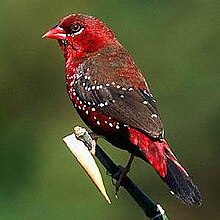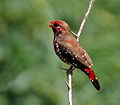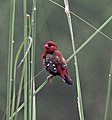ಕೆಂಪು ರಾಟವಾಳ

"ಕೆಂಪು ರಾಟವಾಳ", "ಕೆಂಪು ಮುನಿಯ" ಅಥವಾ "ಸ್ಟ್ರಾಬೇರಿ ಪಿ೦ಚ್" (ಅಮಾಂಡವ ಅಮಾಂಡವ) ಎಂಬುದು ಈ ಹಕ್ಕಿಯ ವೈಜ್ಞಾನಿಕ ಹೆಸರು. ಇದು ಗುಬ್ಬಚ್ಚಿ ಗಾತ್ರದ ಹಕ್ಕಿಯ ಎಸ್ಟ್ರಿಲ್ಡಿಡೇ ಕುಟುಂಬಕ್ಕೆ ಸೇರಿದೆ. ಏಷ್ಯಾದ ಉಷ್ಣವಲಯ ಪ್ರದೇಶದ ಕುರುಚಲು, ಹುಲ್ಲುಗಾವಲು ಪ್ರದೇಶಗಳಲ್ಲಿ ಕಂಡು ಬರುತ್ತದೆ. ಮತ್ತು ಗಂಡು ಹಕ್ಕಿಗಳು ಪಂಜರದಲ್ಲಿ ಸಾಕಲು ಯೋಗ್ಯವಾಗಿದ್ದು , ಸಂತಾನ ಕಾಲದಲ್ಲಿ ವರ್ಣಮಯ ಪುಕ್ಕಗಳ್ಳುಳ್ಳ ಸು೦ದರ ಹಕ್ಕಿ. ಇವುಗಳು ಭಾರತದ ಉಪಖಂಡದ ಪ್ರದೇಶದಲ್ಲಿ ಮಾನ್ಸೂನ್ ಕಾಲದಲ್ಲಿ ಸಂತಾನಕ್ಕೆ ಸಜ್ಜುಗೊಳ್ಳುತ್ತವೆ. ಇದರ ವರ್ಗದ ಹೆಸರು "ಅಮಾಂಡವ" ಮತ್ತು ಇದರ ಸಾಮಾನ್ಯ ಹೆಸರು "ಅವಡವತ್" (avadavat)ಎಂಬುದು, ಗುಜರಾತಿನ ಅಹ್ಮಾದಾಬಾದ್ ನಗರದಲ್ಲಿ ಸಂಶೋಧಿಸಲಾಯಿತು. ಈ ಹಕ್ಕಿಗಳನ್ನು ಸಾಕಲು ಮುದ್ದಾಗಿರುವುದರಿಂದ ಹಲವೆಡೆ ಇವುಗಳ ಮಾರಾಟವು ಸಹ ನಡೆಯುತ್ತದೆ.[೨][೩]
ವಿವರ
[ಬದಲಾಯಿಸಿ]ಈ ಕೆಂಪು ರಾಟವಾಳ ಹಕ್ಕಿಯು ತುಂಬ ಸಣ್ಣ ಪಕ್ಷಿ, ಈ ಹಕ್ಕಿಯನ್ನು ಗುರುತಿಸಲು ಅದರ ಬಾಲದ ಸುತ್ತ ಇರುವ ಕಪ್ಪು ಬಣ್ಣ ಮತ್ತು ಕೆಂಪು ಕೊಕ್ಕಿನಿಂದ ಇದನ್ನು ಸುಲಭವಾಗಿ ಗುರುತಿಸಬಹುದು. ಬಾಲದ ಕೆಳಗೆ ಕೆಂಪು ಮತ್ತು ಸಾಮಾನ್ಯವಾಗಿ ಗಂಡು ಹಕ್ಕಿ ಸಂತಾನಾಭಿವೃದ್ಧಿ ಕಾಲದಲ್ಲಿ ಮೈ ಮೇಲೆಲ್ಲ ಕೆಂಪಾಗಿರುತ್ತದೆ. ಕಣ್ಣು ಮಧ್ಯದಲ್ಲಿ, ಹೊಟ್ಟೆಯ ಕೆಳಗೆ ಮತ್ತು ರೆಕ್ಕೆಗಳು ಕಪ್ಪಗಿದೆ. ಕೆಂಪು ದೇಹ ಮತ್ತು ರೆಕ್ಕೆಯ ಪುಕ್ಕಗಳ ಮೇಲೆ ಬಿಳಿಯ ಚುಕ್ಕಿಗಳು ಇರುತ್ತವೆ. ಸಂತಾನಾಭಿವೃದ್ಧಿಯಿಲ್ಲದ ಕಾಲದಲ್ಲಿ ಗಂಡು ಹಕ್ಕಿಯು ಸ್ವಲ್ಪ ಮಂಕುಬಣ್ಣದಿಂದ ಕೂಡಿರುತ್ತದೆ. ಆದರೆ ಬಾಲದ ಕೆಳಗೆ ಕೆಂಪಗಿರುತ್ತದೆ. ಹೆಣ್ಣು ಹಕ್ಕಿಯು ಯಾವಾಗಲೂ ಮಂಕುಬಣ್ಣವಾಗಿದ್ದು, ರೆಕ್ಕೆಯ ಗರಿಗಳ ಮೇಲೆ ಬಿಳಿಯ ಚುಕ್ಕಿಗಳು ಸ್ವಲ್ಪ ಅಸ್ಪಷ್ಟವಾಗಿ ಕಾಣುತ್ತದೆ.[೪][೫]
ವಿಕಾಸ ಮತ್ತು ವ್ಯವಸ್ಥೆ
[ಬದಲಾಯಿಸಿ]ಜೀನ್ ಡೆಲಕೋರ್ (Jean Delacour) ರವರ ಪ್ರಕಾರ ಮೊದಲು ಕೆಂಪು ಅವಡವಟ್ ಗಳು ಕೂಡ "ಎಸ್ಟ್ರಿಲ್ಡ" ಪ್ರಭೇದಕ್ಕೆ ಸೇರಿದ್ದವು, ಆದರೆ ಇವುಗಳ ಒಳರಚನೆ, ನಡವಳಿಕೆ ಮತ್ತು ಜೀವರಾಸಯನ [೬] ಮತ್ತು ಡಿ ಎನ್ ಎ ಅಧ್ಯಾಯನದಿಂದ ಈಗ "ಅಮಾಂಡವ" ಪ್ರಭೇದಕ್ಕೆ ಸೇರಿಸಲಾಗಿದೆ.[೭][೮][೯] ಈ ಎಸ್ಟ್ರಿಲ್ಡಿನೆ ಪ್ರಭೇದ ಭಾರತ ಭೂಖಂಡದಲ್ಲಿ ವಿಕಸನಗೊಂಡವೆಂದು ತಿಳಿಯಲಾಗಿದೆ. ನಂತರ ಅಫ್ರಿಕಾ ಮತ್ತು ಪೆಸಿಫಿಕ್ ಪ್ರಾಂತ್ಯಗಳಿಗೆ ವಲಸೆ ಹೋದವೆಂದು ತಿಳಿಯಲಾಗಿದೆ. 9 mya ಹಿಂದೆ ಕೆಂಪು ಮುನಿಯಗಳು ಹಸಿರು ಮುನಿಯಗಳಿಂದ ಮಾರ್ಪಟ್ಟಿವೆ.[೧೦]
ಆವಾಸ ಮತ್ತು ಹಂಚಿಕೆ
[ಬದಲಾಯಿಸಿ]ಕೆಂಪು ರಾಟವಾಳಗಳು ಮುಖ್ಯವಾಗಿ ಮೈದಾನ ಪ್ರದೇಶಗಳು, ಎತ್ತರವಾಗಿ ಬೆಳೆದಿರುವ ಹುಲ್ಲುಗಾವಲು ಪ್ರದೇಶಗಳು ಮತ್ತು ಹಲವು ಬಾರಿ ನೀರಿನ ಬಳಿ ಬೆಳೆಯುವ ಕೃಷಿ ಜಾಗಗಳಲ್ಲಿ ಕಂಡುಬರುತ್ತವೆ.[೪] ಇವುಗಳಲ್ಲಿ ನಾಲ್ಕು ಜಾತಿಯ ಹಕ್ಕಿಗಳಿದ್ದು. ಅದರ ಉಪಜಾತಿಗಳನ್ನು ಬಾಂಗ್ಲದೇಶ, ಭಾರತ, ಶ್ರೀಲಂಕ, ನೇಪಾಳ ಮತ್ತು ಪಾಕೀಸ್ತಾನಗಳಲ್ಲಿ ಸೂಚಿಸಲಾಗಿದೆ; ಬರ್ಮಾಕ್ಕೆ ಸಂಬಂಧಿಸಿದ ಹಾಗೆ "ಫ್ಲಾವಿಡಿವೆಂಟ್ರಿಸ್" ಎಂತಲೂ. ಹಾಗೆಯೇ ಚೀನಾದ ಕೆಲ ಭಾಗ, ಇಂಡೋನೆಷಿಯ, ಥೈಲ್ಯಾಂಡ್ ಮತ್ತು ವಿಯಾಟ್ನಂ)ನಲ್ಲು ಕರೆಯುವರು;[೧೧]ಜಾವದ ಪೂರ್ವದ ಜನಗಳು punicea ಎಂತಲೂ ಮತ್ತು ಕಾಂಬೊಡಿಯಾದಲ್ಲಿ decouxi ಎಂತಲೂ ಕರೆಯುತ್ತಾರೆ.[೧೨][೧೩][೧೪][೧೫]
ದಕ್ಷಿಣ ಸ್ಪೈನ್ ನಲ್ಲಿ ಇವುಗಳ ಸಾಂದ್ರತೆ ಕಾಣಸಿಗುತ್ತವೆ[೧೬] Brunei, Fiji,[೧೭] ಈಜಿಪ್ಟ್[೧೮]ಮಲೇಶಿಯಾ,ಪೋರ್ಚ್ ಗಲ್, ಪೂರ್ಟೋ ರಿಕೋ,ಸಿಂಗಪೂರ್ ಮತ್ತು ಹವೈ[೧೯][೨೦]
ವರ್ತನೆ ಮತ್ತು ಪರಿಸರ
[ಬದಲಾಯಿಸಿ]ಸಾಮಾನ್ಯವಾಗಿ ಈ ಸಣ್ಣ ಜಾತಿಯ ಹಕ್ಕಿಗಳು ಸಣ್ಣಸಣ್ಣ ಗುಂಪುಗಳಲ್ಲಿರುತ್ತವೆ.[೨೧] ವೇಗವಾಗಿ ರೆಕ್ಕೆ ಬಡಿದುಹಾರುವುದರಿಂದ ಮತ್ತು ಹಸಿರು ಪೊದೆಗಳಲ್ಲಿ ಇರುವುದರಿಂದ ಇವುಗಳು ಕಾಣಸಿಗುವುದು ತುಂಬ ವಿರಳ. ಸಂತಾನೋತ್ಪತಿ ಸಮಯದಲ್ಲಿ ಜೊತೆ ಜೊತೆಯಾಗಿ ಈ ಹಕ್ಕಿಗಳಿರುತ್ತವೆ,[೨೨] ಈ ಹಕ್ಕಿಗಳು ಹಾರಿದ ನಂತರ ವಿಭಿನ್ನ ರೀತಿಯ ಸಣ್ಣ ದನಿಯಲ್ಲಿ "ಪ್ಸೀಪ್ ಪ್ " ಎಂದು ಕೂಗುತ್ತವೆ.[೨೩] ಗುಂಪಿನಲ್ಲಿರುವ ಈ ಹಕ್ಕಿಗಳು ತಲೆಯ ಮೇಲಿನ ಪುಕ್ಕಗಳನ್ನು ಕದಡಿ ಒಂದು ಹಕ್ಕಿ ಮತ್ತೊಂದು ಹಕ್ಕಿಯ ರೆಕ್ಕೆಗಳನ್ನು ಸರಿಪಡಿಸಿಕೊಳ್ಳಲು ಆಹ್ವಾನಿಸುತ್ತವೆ.[೨೪] ಸಾಮಾನ್ಯವಾಗಿ ಕಾಳುಗಳನ್ನು ತಿಂದು ಜೀವಿಸುವ ಈ ಹಕ್ಕಿಗಳು ಗೆದ್ದಲು ಹುಳುಗಳನ್ನು ತಿನ್ನುತ್ತವೆ.[೨೫]
ಹುಲ್ಲಿನ ಗರಿಗಳಿಂದ ವೃತ್ತಾಕಾರವಾಗಿ ತನ್ನ ಗೂಡನ್ನು ಕಟ್ಟಿಕೊಳ್ಳುತ್ತವೆ. ಸಾಮಾನ್ಯವಾಗಿ ಈ ಹಕ್ಕಿಗಳು ಸುಮಾರು 5 ರಿಂದ 6 ಬಿಳಿ ಬಣ್ಣದ ಮೊಟ್ಟೆಗಳನ್ನು ಇಡುತ್ತವೆ.[೨೬]
-
Male in ಕೊಲ್ಕತ್ತ, West Bengal, India.
-
In flock in ಕೊಲ್ಕತ್ತ, West Bengal, India.
-
Male & Female at Pocharam lake, ಆಂಧ್ರ ಪ್ರದೇಶ, India.
-
Male in Manjira Wildlife Sanctuary, ಆಂಧ್ರ ಪ್ರದೇಶ, India.
-
Male in Rajkot, Gujarat, India.
-
Male in Mohali, Punjab, India.
ಏಪ್ರಿಲ್ ನಲ್ಲಿ ಪೂರ್ತಿ ಕಪ್ಪಾಗಿರುವ ಕೊಕ್ಕು, ಮೇ ತಿಂಗಳಲ್ಲಿ ಕೆಂಪು ಬಣ್ಣಕ್ಕೆ ತಿರುಗಿ, ನವೆಂಬರ್ ಮತ್ತು ಡಿಸೆಂಬರ್ ನಲ್ಲಿ ಕೊಕ್ಕಿನ ಬಣ್ಣ ಕಪ್ಪಾಗುತ್ತದೆ. [೨೭] ವಾತಾವರಣಕ್ಕೆ ತಕ್ಕಂತೆ ಹಕ್ಕಿಯ ಬಾಹ್ಯ ರಚನೆಯು ಏರುಪೇರಾಗುತ್ತದೆ.[೨೮] ಉಣ್ಣೆಯಂತಹ ಪರಾವಲಂಬಿ ಜೀವಿಗಳನ್ನು ತಿನ್ನುವ ಹಕ್ಕಿಗಳಲ್ಲಿ ಇಂಕ್ನೋಸಿರ. “ಬ್ರೂಲಿಯ ಅಮಂಡವ" ಮತ್ತು ಅಂಬ್ಲೈಸಿರ, “ಮೈರ್ಸಿಡೇ ಅಮಂಡವ " ಎಂದು ಗುರುತಿಸಲಾಗಿದೆ.
[೨೯] ಮತ್ತು ಈ ಪಕ್ಷಿಗಳಿಂದ ತೆಗೆದ ಪರಮೈಕ್ಸೋ ವೈರಸ್ ಜಪಾನ್ ನಲ್ಲಿ ಇಡಲಾಗಿದೆ.[೩೦][೩೧]
ಉಲ್ಲೇಖಗಳು
[ಬದಲಾಯಿಸಿ]- ↑ BirdLife International (2012). "Amandava amandava". IUCN Red List of Threatened Species. Version 2012.1. International Union for Conservation of Nature. Retrieved 16 July 2012.
((cite web)): Invalid|ref=harv(help) - ↑ Pittie A (2004). "A dictionary of scientific bird names originating from the Indian region" (PDF). Buceros. 9 (2). Archived from the original (PDF) on 2009-04-10. Retrieved 2013-09-28.
- ↑ Yule H (1886). Hobson-Jobson:A glossary of Anglo-Indian colloquial words and phrases. John Murray. p. 30.
- ↑ ೪.೦ ೪.೧ Rasmussen PC & JC Anderton (2005). Birds of South Asia: The Ripley Guide. Volume 2. Smithsonian Institution & Lynx Edicions. p. 572.
- ↑ Whistler, Hugh (1949). Popular Handbook of Indian Birds. Gurney and Jackson. pp. 216–217.
- ↑ Christidis, L (1987). "Biochemical systematics within Palaeotropic finches (Aves: Estrildidae)" (PDF). The Auk. 104 (3): 380–392. doi:10.2307/4087534.
- ↑ Harrison, CJO (1962). "An ethological comparison of some waxbills (Estrildini), and its relevance to their taxonomy". Proceedings of the Zoological Society of London. 139 (2): 261–282. doi:10.1111/j.1469-7998.1962.tb01830.x.
- ↑ Delacour, Jean (1943). "A revision of the subfamily Estrildinae of the family Ploceidae". Zoologica. 28: 69–86.
- ↑ Webster, J D (2007). "Skeletal characters and the systematics of Estrildid finches (Aves:Estrildidae)". Proceedings of the Indiana Academy of Science. 116 (1): 90–107. Archived from the original on 2011-05-24. Retrieved 2013-09-28.
- ↑ Arnaiz-Villena, A (2009). "Estrildinae Finches (Aves, Passeriformes) from Africa, South Asia and Australia: a Molecular Phylogeographic Study" (PDF). The Open Ornithology Journal. 2: 29–36. doi:10.2174/1874453200902010029. Archived from the original (PDF) on 2012-03-21. Retrieved 2013-09-28.
((cite journal)): Unknown parameter|coauthors=ignored (|author=suggested) (help) - ↑ Baker, ECS (1921). "The birds of the Indian Empire: Hand-list of the "Birds of India", Part 3". J. Bombay Nat. Hist. Soc. 27 (4): 692–744.
- ↑ Oates, EW (1890). Fauna of British India. Birds. Volume 2. Taylor and Francis, London. pp. 192–193.
- ↑ Deignan, HG (1963). "Checklist of the birds of Thailand". National Museum Bulletin. 226: 216.
- ↑ Paynter RA (Ed) (1968). Check-list of the birds of the world. Vol. 14. Museum of Comparative Zoology. pp. 348–349.
- ↑ Baker ECS (1926). Fauna of British India. Birds. Volume 3 (2 ed.). Taylor and Francis. pp. 95–97.
- ↑ De Lope F.; Guerrero J. ; De La Cruz C. (1984). "Une nouvelle espèce à classer parmi les oiseaux de la Péninsule Ibérique: Estrilda (Amandava) amandava L. (Ploceidae, Passeriformes)". Alauda. 52 (4).
((cite journal)): Unknown parameter|trans_title=ignored (help)CS1 maint: multiple names: authors list (link) - ↑ Langham, NPE (1987). "The Annual Cycle of the Avadavat Amandava amandava in Fiji". Emu. 87 (4): 232–243. doi:10.1071/MU9870232.
- ↑ Nicoll, MJ (1919). Handlist of the birds of Egypt. Government Press, Cairo. p. 30.
- ↑ Barre N. ; Benito-Espinal E. (1985). "Oiseaux granivores exotiques implantés en Guadeloupe, à Marie-Galante et en Martinique (Antilles françaises)". L'Oiseau et la Revue française d'Ornithologie. 55 (3): 235–241.
((cite journal)): Unknown parameter|trans_title=ignored (help)CS1 maint: multiple names: authors list (link) - ↑ Ticehurst, CB (1930). "The Amandavat (Aamandava amandava) in Mesopotamia". J. Bombay Nat. Hist. Soc. 34 (2): 576.
- ↑ Evans, SM (1970). "Some factors affecting the flock behaviour of red avadavats (Amandava amandava) with particular reference to clumping". Animal Behaviour. 18 (4): 762–767. doi:10.1016/0003-3472(70)90025-4.
- ↑ Sparks, JH (1964). "Flock structure of the Red Avadavat with particular references to clumping and allopreening". J. Anim. Behaviour. 12: 125–126. doi:10.1016/0003-3472(64)90113-7.
- ↑ Ali S & SD Ripley (1999). Handbook of the birds of India and Pakistan. Vol. 10 (2 ed.). Oxford University Press. pp. 106–108.
- ↑ Sparks, John H. (1965). "On the role of allopreening invitation behaviour in reducing aggression among red avadavats, with comments on its evolution in the Spermestidae". Journal of Zoology. 145 (3): 387. doi:10.1111/j.1469-7998.1965.tb02024.x.
- ↑ Inglis, CM (1910). "Note on the Spotted Munia (Uroloncha punctulata) and the Indian Red Munia (Sporaeginthus amandava)". J. Bombay Nat. Hist. Soc. 20 (2): 517–518.
- ↑ Hume, AO (1890). The nests and eggs of Indian Birds. Vol. 2. R H Porter, London. pp. 147–149.
- ↑ Thapliyal, JP & BBP Gupta (1984). "Thyroid and annual gonad development, body weight, plumage pigmentation, and bill color cycles of Lal Munia, Estrilda amandava". Gen. Comp. Endocrinology. 55 (1): 20–28. doi:10.1016/0016-6480(84)90124-2. PMID 6745630.
- ↑ Subramanian, P & R Subbaraj (1989). "Seasonal changes in the timing of hopping and feeding activities of a tropical bird (Estrilda amandava) under natural photoperiod". Proc. Indian Acad. Sci. (Anim. Sci.). 98 (2): 89–93. doi:10.1007/BF03179631.
- ↑ Gupta, N., Kumar, S., Saxena, A.K. (2007). "Prevalence and population structure of lice (Phthiraptera) on the Indian Red Avadavat". Zoological Science. 24 (4): 381–383. doi:10.2108/zsj.24.000. PMID 17867828.
((cite journal)): CS1 maint: multiple names: authors list (link) - ↑ Matsuoka, Y; H Kida & R Yanagawa (1980). "A new paramyxovirus isolated from an Amaduvade Finch (Estrilda amandava)" (PDF). Jpn. J. Vet. Sci. 42 (2): 161–167. doi:10.1292/jvms1939.42.161. Archived from the original (PDF) on 2011-07-22. Retrieved 2013-09-28.
((cite journal)): CS1 maint: multiple names: authors list (link) - ↑ Rékási, J. & Saxena, A. K. (2005). "A new Phthiraptera species (Philopteridae) from the Red Avadavat (Amandava amandava)" (PDF). Aquila. 112: 87–93. Archived from the original (PDF) on 2012-03-29. Retrieved 2013-09-28.
((cite journal)): CS1 maint: multiple names: authors list (link)
ಅನ್ಯ ಮೂಲಗಳು
[ಬದಲಾಯಿಸಿ]- Photos and videos Archived 2016-04-19 ವೇಬ್ಯಾಕ್ ಮೆಷಿನ್ ನಲ್ಲಿ.
- BirdLife Species Factsheet Archived 2007-09-29 ವೇಬ್ಯಾಕ್ ಮೆಷಿನ್ ನಲ್ಲಿ.
Text is available under the CC BY-SA 4.0 license; additional terms may apply.
Images, videos and audio are available under their respective licenses.








